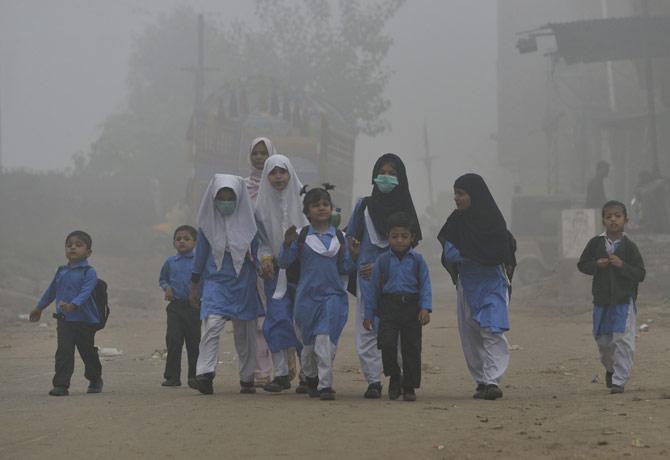Smog-filled cities in north India and Pakistan will continue to experience dangerous level of air quality over the next several months, a top American atmospheric organisation has said, warning that the cities could turn into dangerously unhealthy

Smog-filled cities in north India and Pakistan will continue to experience dangerous level of air quality over the next several months, a top American atmospheric organisation has said, warning that the cities could turn into dangerously unhealthy "snow globes". "This is just the start to the smog season in northern India and Pakistan, as the monsoon will last for much of the upcoming winter. That means there are plenty of more opportunities for cold, stagnant air to fill with pollution, turning cities into dangerously unhealthy snow globes," National Oceanic and Atmospheric Administration (NOAA) said in a statement yesterday.
ADVERTISEMENT

This file photo taken on November 6, 2017 shows Pakistani children walking to school in heavy smog in Lahore. The toxic smog that has covered parts of Pakistan for weeks has exposed official torpor against rampant pollution which has killed thousands more people in the fast-growing country than years of militancy. Pic/AFP
NOAA released satellite pictures and explained the reasons behind such a polluting atmosphere in major parts of north India and Pakistan. Widespread smog caused by the combustion of fuels, and the burning of crops and fires made it dangerous to be outside in cities in northern India and Pakistan, it said. For air to get this polluted, in addition to needing a good amount of human help from the combustion of fuels and burning of crops and garbage, there needs to be specific atmospheric conditions that let the air remain still enough for pollution accumulate, it said.
"This stagnation occurs when there is an inversion layer in the atmosphere," NOAA said. An inversion layer refers to instances where the air does not cool as one moves up in the atmosphere, it explained. "Instead, warmer air sits on top of denser, colder air near the ground. Since that cold air has no place to go thanks to the warm lid placed atop it, it just sits there gathering pollution like a hazy snow-globe," NOAA said. So, in late fall across the Indian Sub continent, the Northeast Monsoon is beginning to take hold, it said, adding that, the Northeast monsoon is driven by temperatures differences between the land and surrounding waters.
At this time of year, the large landmass to the north begins to cool down considerably forming a dense, cold air mass known as the Siberia high pressure system. Meanwhile, the waters off of India remain warm. This contrast draws northerly winds across northern India, bringing cold air down off the Tibetan Plateau. The cold air settles into the valleys, creating inversions, NOAA said. Referring to satellite images, NOAA said the widespread burning of crop fields in northern India contributed to dangerous levels of air pollution in cities across northern India and Pakistan.
At the US Embassy in New Delhi, hourly AQI values for PM2.5 taken on November 7 through 10 exceeded 500 with an astounding recording of 1010 at 4PM local time on November 8. Hourly readings still peaked in the Hazardous category (301-500 AQI) through November 14. New Delhi and several other North Indian states has been experiencing dense smog for over a week, forcing authorities to enforce emergency measures such as banning construction activities and brick kilns. In Pakistan, bad weather conditions caused by smog have disrupted over 600 PIA flights this month. The smoggy conditions in the country's Punjab province forced the airline to either delay or cancel the flights.
 Subscribe today by clicking the link and stay updated with the latest news!" Click here!
Subscribe today by clicking the link and stay updated with the latest news!" Click here!







